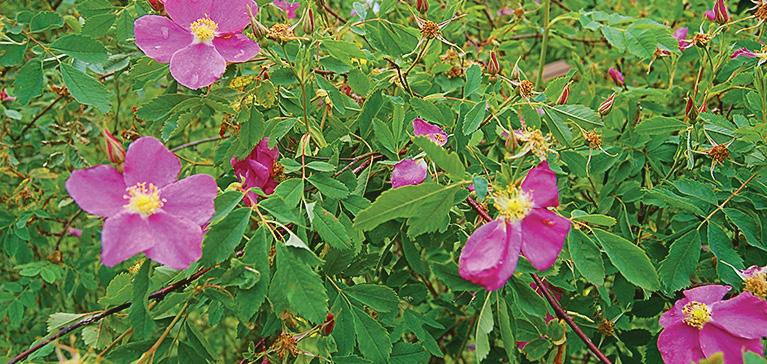
4 minute read
Property Lines
Nature-Scape Your Horse Property
Native plants and animals can serve both utilitarian and delightful functions on horse properties.
Put native plants, birds, and bats to work on your horse property to nurture the land, and help control insects and rodents. Article and Photos by Alayne Blickle
Did you know that there are a great many wonderful ways that plants and animals can actually work for you on your horse property? Native plants and animals can serve both utilitarian and delightful aesthetic functions on your horse property—all while saving you time and money, and reducing your impact on the environment.
Creating a natural habitat might increase your property value, too. The United States Fish & Wildlife Service Office of Migratory Bird Management reports that homes in neighborhoods with large trees for birds are worth more than similar homes in neighborhoods without trees.
Native plants are the ones that grow in your area naturally. They generally cost less to buy than non-native landscaping plants and are equally attractive.
Native plants are better adapted to local climate and soil conditions than exotics, and are more insect- and disease-resistant, than non-native ones, so you’ll be less likely to need to help them along with pesticides, fertilizers, and even extra watering after they’re established.
Following are eight reasons to “go native.” >>
Minimize mud. Native plants and trees can help dry up an annoying wet area or be the first line of defense in intercepting runoff from the hillside behind your property. A mature Douglas fir can use from 125 to 150 gallons a day. Other types of water-loving plants include willow, dogwood, cottonwood, aspen, and cedar. Vegetated swales channel away surface water. And, if placed down slope from your horse’s paddock, they can pick up excess water and nutrient runoff. Check with your local extension agent or conservation district for specific recommendations on plants suitable for your area and soils. Bust the dust. Use native plants to help cut down on blowing dust from your arena, polluting your neighbor’s property. Generally, a buffer of at least 20 feet deep is recommended. This buffer should include evergreens, deciduous trees, and shrubs. A row of evergreens makes a nice privacy screen between you and your neighbor.
Woods’ roses smell wonderful and are an important food source for certain animals.

Provide timely sun and shade. Well-placed deciduous trees and shrubs around your barn and paddocks can provide cooling shade in the summer, while the bare branches in the winter allow the warming rays from the sun to reach through to your horses. Control erosion. Trees and shrubs hold valuable topsoil in place, keeping it from getting washed away by rain or blown away by wind, which can potentially cause a surface water or groundwater problem. If you’re raising pasture grass, protecting valuable topsoil is paramount. Plants need soil and nutrients to be healthy, so put those native plants to work as a filter strip to catch nutrients and hold topsoil in place. Control runoff. Native plants are also useful around streams, ponds, wetlands, and other water bodies. Trees and undergrowth are nature’s system for filtering runoff contaminants, such as nutrients from manure and sediment from mud.
PHOTO BY ALAYNE BLICKLE Encourage insect-eating swallows to move onto your horse property to reduce the flying-insect population.

Feed fish. Vegetation supplies food and shelter for fish and other aquatic life. The overhead canopy trees keep water cool. Cool water is able to carry more oxygen than warm water, which benefits fish. Banish bugs. One swallow consumes thousands of insects per day. During the spring and summer, violet green, cliff, and barn swallows can be seen and heard diving, darting, and chirping on horse properties throughout much of the United States. Other types of insect-eating birds include other types of swallows, bluebirds, and purple martins.
Lure insect-eating birds to your property by providing a habitat for them. Help them build their nests by putting out tufts of horse and dog hair. Also, build or buy nesting boxes specific to the type of swallows in your area.
Encourage bats to take up residence. One bat can eat hundreds of mosquitoes in an hour. Create a friendly bat habitat with bat houses. Place a bat house on a barn, pole, tree, and/or the side of a house, ideally within a half-mile of a stream, lake, or wetland. Note that it can take up to two years for a bat colony to find your house. Control rodents. Encourage larger birds—such as owls, hawks, and falcons, which prey on problem rodents—to be a part of your habitat. Protect large trees and snags that provide housing for these predators. Some of these bird species also do well in nest boxes.
Plant trees outside of confinement areas and pastures to keep trees away from teeth and hooves. Trees inside these areas should be protected to the end of their “drip zone,” or the tips of their branches. To protect your trees, use fencing and physical barriers, such as large rocks and logs. USR









